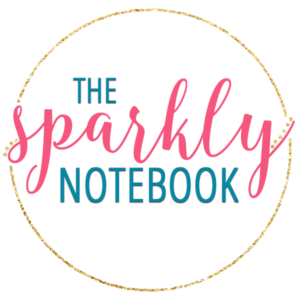A breakdown for teachers who teach RI.5 in middle school ELA. In this post, we’ve included learning targets, concept breakdowns, resource suggestions, and activity and assessment ideas!
Nothing happens by accident.
It is an interesting thought, but it is often true when it comes to writing.
Word choice, paragraph breakdown, chapter names, etc., are all used to convey a message, get the point across, or bring the reader’s attention to something important.
When we teach RI.5 in middle school, we are teaching students to pay attention to the structure and organization of a text.
We are teaching them to find the purpose in the way the information is organized in an informational text.
We are asking them to consider what the author’s real goal was from the beginning and how the organization and structure contributed to that goal.
As we start talking about how to teach RI.5 in middle school, let’s start with breaking the standard down into learning targets!
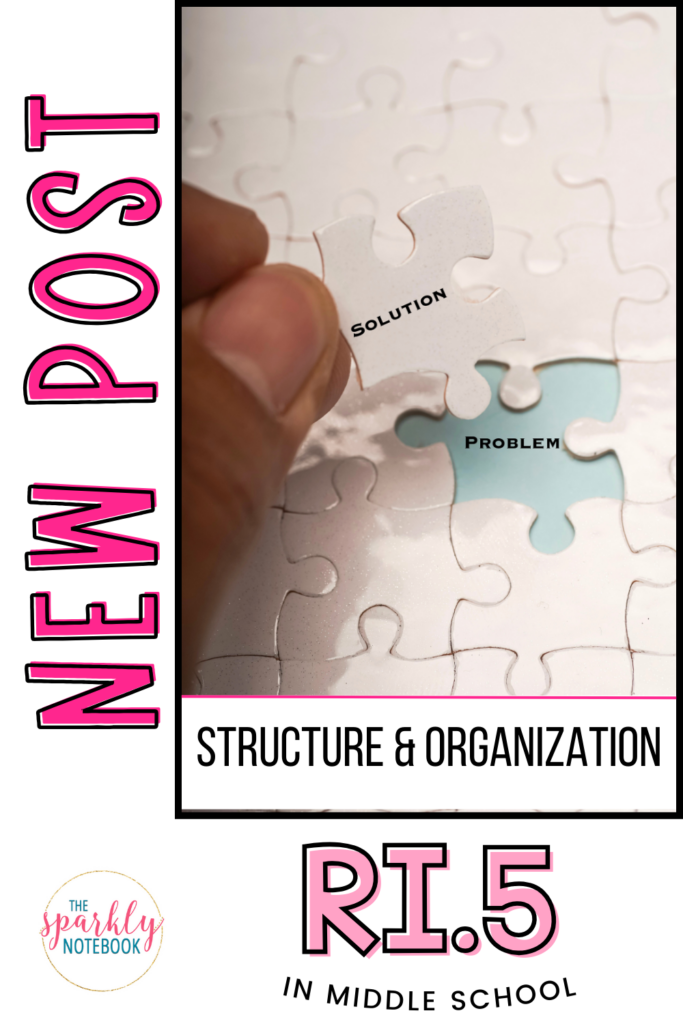
Learning Targets
Learning targets help us break our big standards with multiple points and skills down into manageable pieces that we can focus on one at a time.
I like to use standards checklists like the ones below as I begin to plan out my learning targets and when I’m going to cover each standard throughout the year.
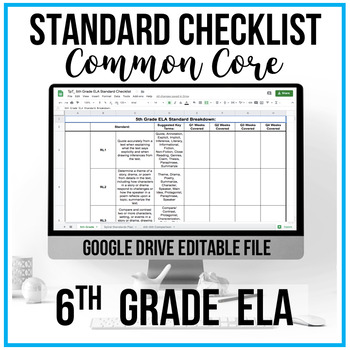
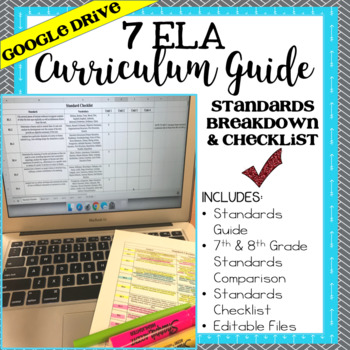
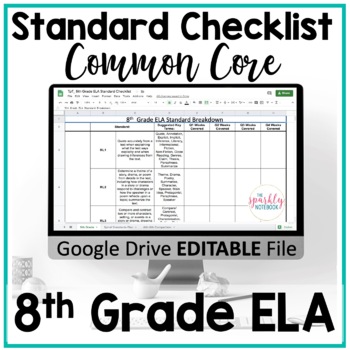
When starting to deconstruct a standard, start with the learning targets. To get the learning targets, break down the standard into 2-5 parts or key skills.
Let’s take a look at the RI.5 middle school standards, and then we’ll list the learning targets we decided to focus on for this standard.
Teaching RI.6.5 (6th Grade)
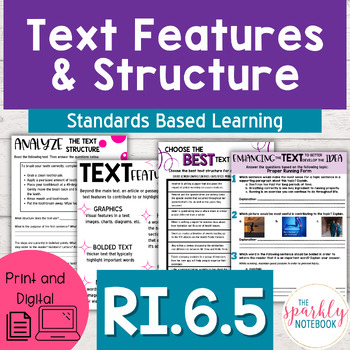
6th Grade Standard: Analyze how a particular sentence, paragraph, chapter, or section fits into the overall structure of a text and contributes to the development of the ideas.
6th Grade Learning Targets
- I can recognize text structure through chronology, comparison, cause/effect, and problem/solution.
- I can analyze how particular sentences, paragraphs, chapters, sections, and text features support the textual structure.
- I can analyze how particular sentences, paragraphs, chapters, sections, and textual features contribute to idea development.
Teaching RI.7.5 (7th Grade)
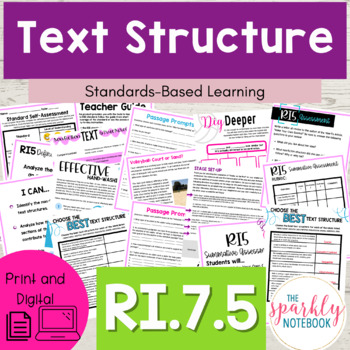
7th Grade Standard: Analyze the structure an author uses to organize a text, including how the major sections contribute to the whole and to the development of the ideas.
7th Grade Learning Targets
- I can identify the nonfiction text structures.
- I can analyze how the major sections of the text contribute to the whole.
- I can explain how an author uses the text structure to develop ideas.
Teaching RI.8.5 (8th Grade)
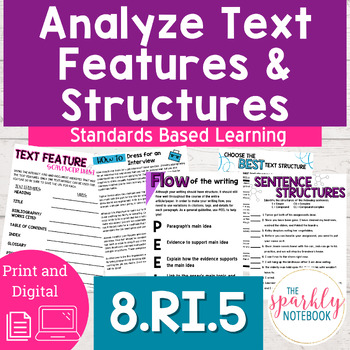
8th Grade Standard: Analyze in detail the structure of a specific paragraph in a text, including the role of particular sentences in developing and refining a key concept.
8th Grade Learning Targets
- I can analyze and evaluate common textual features.
- I can analyze and evaluate common text structures.
- I can examine the structure of a specific paragraph in a text as well as examine the role of particular sentences in developing and refining a key concept.
Growing through Middle School
Interestingly, the change in this standard from 7th grade to 8th grade is actually the opposite of what you might expect.
It seems like we often go from the smaller section of text (like a paragraph or sentence) in 7th grade and then to a bigger section of text (like a chapter or the work as a whole) in 8th grade, but this standard actually goes the opposite way.
In 7th grade, we focus on the whole of the text; in 8th grade, we focus on the development and form of the individual paragraphs.
You’ll want to keep these differences in mind as you consider what pieces of text you’ll work with as you practice this standard.
Starting with Text Structures
When working with 6th and 7th graders on this standard, you’ll spend a lot of time and effort learning about and identifying different text structures. In order for students to understand the decisions an author is making in a text, they need to know the purpose of the text, and identifying the text structure can help with that.
Here is a list of text structures we recommend working on with students in middle school.
Text Structures
- Compare/Contrast
- Cause/Effect
- Order of Importance
- Problem/Solution
- Sequential
- Chronological
- Spatial
- Descriptions/List
Once students can identify which structure is being used, they can consider the text details through the lens of that structure and purpose.
In 8th grade, as students turn more toward breaking down a smaller portion of the text, they’ll still want to begin the lesson by identifying the structure being used throughout the whole text before narrowing their focus to an individual portion.
At that point, they will spend their time looking into the development of the paragraph, sentence structure, word choice, and how points and evidence are introduced and developed.
Resources for teaching RI.5
We have designed fully built-out resources for each of the 6th, 7th and 8th grade ELA standards. Each resource is grade-level specific and is designed around the little nuances that make 7th and 8th grades just a little different from each other.
Click on the links below to look into each grade-level resource in more detail.
Each of the resources works through the standard using grade-level-specific passages and activities that help the student develop the standard completely.
The resources also include a lesson/activity for each specific learning target or concept and also include assessments, posters, and answer keys.
Activities and Projects for Practicing and Assessing RI.5 in Middle School
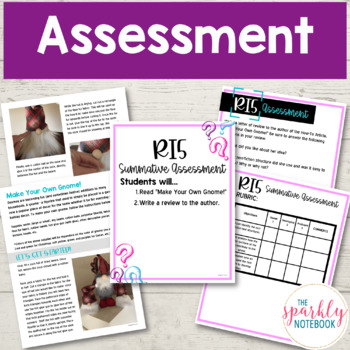
In 6th grade, students focus primarily on text structures and text features and how these components contribute to idea development.
Here are a couple of activities we’ve included in the 6th-grade resource.
- Design an Infographic: Students take a piece of writing and better position the information into an infographic to provide clarity.
- Enhancing the Text to Better Develop the Idea: Students make a series of choices about text, images, text features, etc. to show their understanding of how these different components enhance a text.
In 7th grade, students need exposure to several different kinds of texts so they can consider the different structures and features being used. Consider using projects and activities that expose them to dramas, modern informational texts (like blog posts or social media posts), and classic informational texts like encyclopedias, research papers, and newspaper articles.
Here are a few projects and activities that we’ve included in our 7th-grade resource.
- Choose the Best Text Structure: This activity gives students a chance to consider which text structure would be best for conveying a specific type of message.
- Set the Stage: Consider how a playwright develops and writes a script. How do they describe where items are placed or where characters come onto the stage? This is an example of organization that is very specific to this type of writing. Have students read a short script or the beginning of the script and map out the stage direction.
In 8th grade, students are asked to focus on smaller pieces of an overall text like a paragraph.
Here are some examples of projects and activities we’ve developed for practicing this standard.
- Text Features Scavenger Hunt: Make a list of text features and ask students to find and label them in a text.
- Identifying Sentence Structures: Give students a variety of sentences using different sentence structures, and see if they can figure out what different sentence structures are being used in each.
The middle school ELA standards can sometimes feel like a huge to-do list for teachers, but by breaking the standards down into learning targets, each piece of that list feels easier to accomplish.
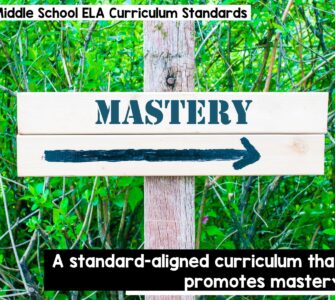 A standard-aligned curriculum that promotes mastery
A standard-aligned curriculum that promotes mastery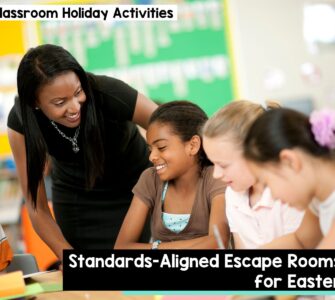 Standards-Aligned Escape Rooms for Easter
Standards-Aligned Escape Rooms for Easter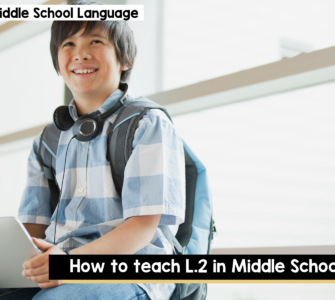 How to teach L.2 in Middle School
How to teach L.2 in Middle School 